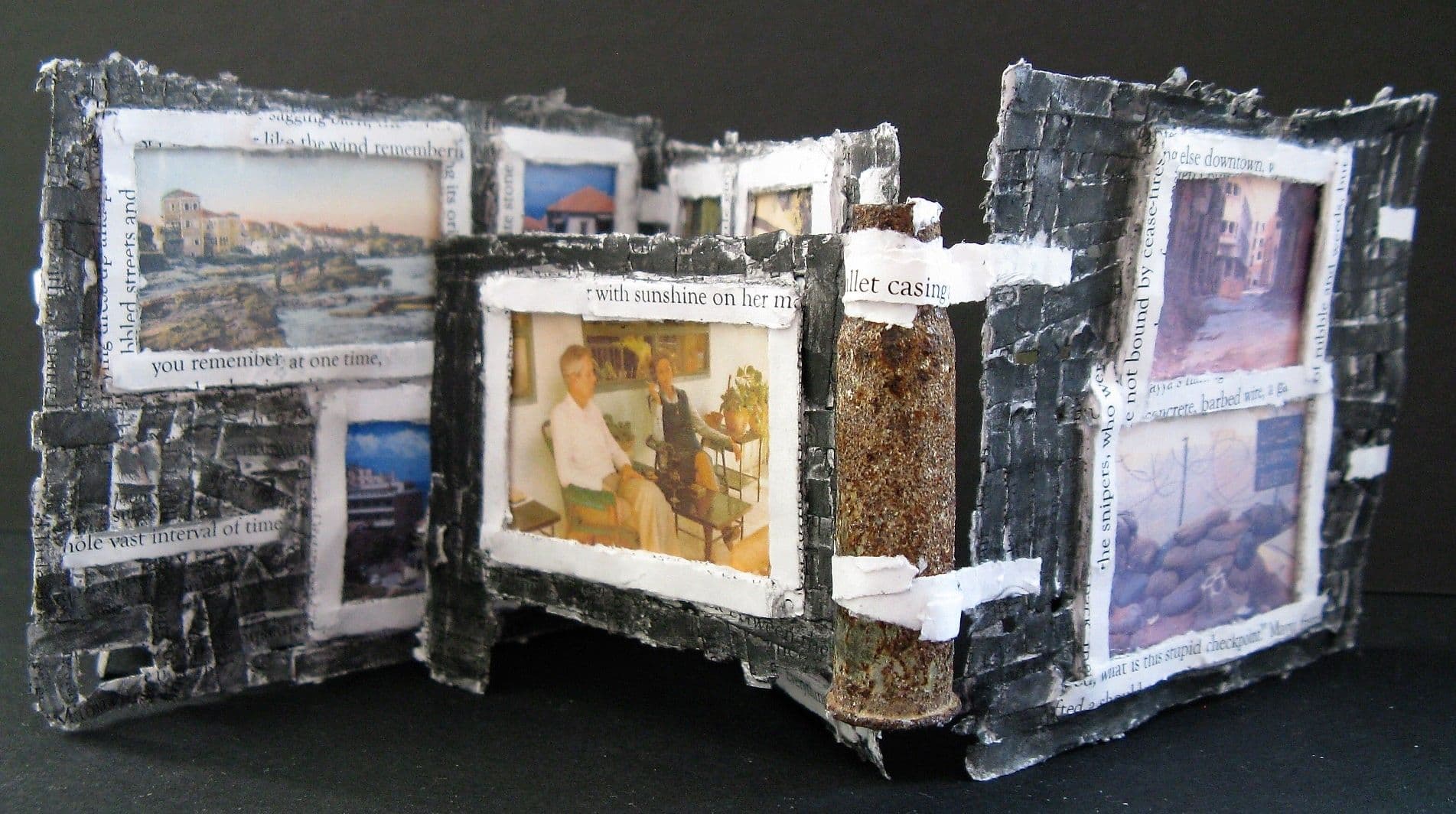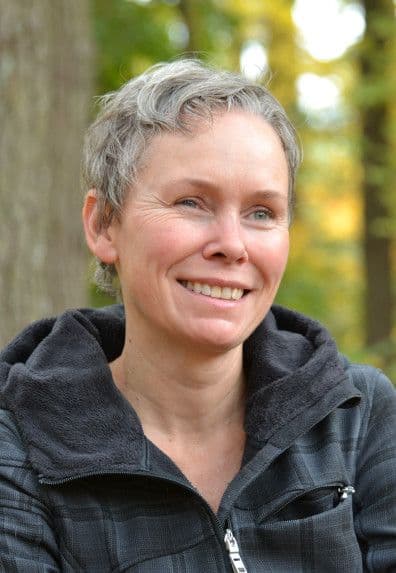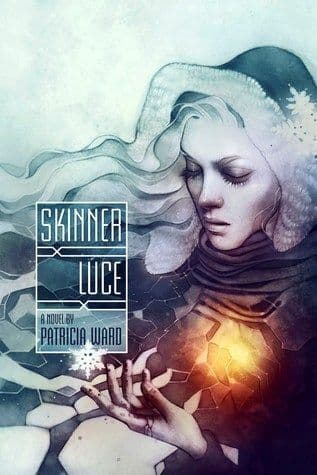
AUTHOR AND ARTIST

I came to St. Stephen’s halfway through tenth grade. I was acting out a lot in Beirut, and my parents felt I’d be better off getting away. Looking back, that was no doubt true, but it wasn’t a magic cure, either. I was a real mess. I got into a lot of trouble at SSS, to the point that the principal wanted to expel me about a month in, but luckily the Head of Boarding had taken me under her wing and advocated on my behalf. It was a really rough time, to be honest, and things carried on that way pretty much through graduation (and beyond).
That said, enough years have passed for me to be able to make space for the good stuff, too. Going to some reunions and staying connected with old friends on social media has made a huge difference in finding a more balanced perspective. I do have very fond memories that coexist with the difficult ones, and I am finally able to give them the same weight. We had some good times, we were teenagers ... When my son asks for details, I tell him, “It was the 80s.” Being in Rome was of course an incredible experience, and we had so much freedom to come and go. We had lots of hangouts (Pace, Spanish Steps, etc) where we’d lounge around for hours, talking and meeting people. Teenagers don’t seem to get that kind of time anymore. It’s a precious thing. The friendships I’ve rekindled since then are particularly profound; there’s something about sharing those teenage years that can never be matched.
And of course, the education at St. Stephen’s was incomparable. Small classes, a lot of attention, caring teachers. Aside from the academics, we kids forged real friendships with teachers that continue to this day. It was really something special.
It very much did, both in the conventional sense and otherwise. The teachers I had at St. Stephen’s were so supportive of my creativity. I remember writing an essay that was all in bits and pieces, in the voice of Alice in Wonderland. I can’t remember what I was supposed to be writing about, but it wasn’t that. The essay still got an A. I also won a short story contest after being accused of plagiarism. The judges thought I was copying Death In Venice; I’d never even heard of it. They ended up giving me the book for my prize. The art teacher supported my work so much that she gave me a key to the art room. I’d go down there late at night and paint and bum around. It was fantastic to have that space to myself.
In the more unconventional sense, the freedom I had to go out into that beautiful city created so many stories that are still emerging in my writing to this day. You have to live life to be able to make art, and St. Stephen’s allowed that for all of us. We had free time after school to sign out and go wherever, so long as we were back for dinner and study hall. That kind of freedom is so important for an artist, even if (or perhaps because) it comes now and then with a price.
When my son was born I went through a grueling postpartum depression that was defined in part by feeling as if I could no longer write. Very soon after he was born I started drawing cartoons about the experience of being a new mom, from pumping almost non-existent milk to using gentian violet for mastitis. Yup, really fun times. I made a pop-up book eventually, then turned the story into a web cartoon. I haven’t gotten around to finishing and uploading, but here’s the main page so you get the idea: www.ifihaveababy.com. Cartooning helped a lot during that period. I then moved on to making small books and objects. It felt good to be able to finish something, versus embarking on a novel. Still, it felt more like a hobby than something I’d really dive into.
Then, when my son was about two, I revised and sent in a novel, and it got rejected. I was in a bad place mentally and emotionally—we’d just moved again and then my husband had lost his new job, so things were very shaky for us. I found myself getting really, really mad that, on top of all our problems, I was suffering from this dumb pressure to publish. I missed writing the way it was when I was a teenager—writing to write, with no clue about publishing, with no stress about whether or not it’s ‘good enough.’ At the same time as all this upheaval was going on, I’d been making tiny painted tunnel books. I looked at the manuscript, looked at all the bits of paper on the art side of my room, and then I thought of the paper shredder ... this is when book arts really took off for me. I made the installation Re/Vision out of my shredded novel and then just kept going. I stayed deep in book arts for about five years, and then, at some point, I’m not sure how or when, I returned to writing, and eventually Skinner Luce was published. Now, for the most part, I am back to writing full-time, though I do still make paper objects now and then. I’ve also taken up patchwork sewing. These art forms provide great balance with my writing.
When I first started making books, I couldn’t figure out how to incorporate language into these tiny works. Every time I tried to write something to put in a small handmade book, it looked really stupid. So I stuck with making ornate tunnel books for a while. It wasn’t until I shredded my novel and shaped all those language fragments into 3D objects and collages that I found my book arts voice. And, not too surprisingly, in all the works I made following that, I returned to the same themes I’d explored in my writing. I think book arts helped me process/cope with those subjects in a more direct way -- instead of weaving them into a huge, wordy mass where they ended up in a way disguised, in the book-objects I made, I left no space for that. The feelings and themes are totally bare and obvious. One of the books I made, The Same One Place, I actually refer to as the sequel to The Bullet Collection. And it truly is the sequel, that’s not a joke. It’s kind of astonishing.

Well, it’s sort of odd how all that started, but it was really because of my husband. He did his duty and read The Bullet Collection and all my short stories and poems, of course, but in the end he’s just not a ‘literary’ fiction reader. He’s always liked fantasy. I found the fantasy books he was reading to be pretty bad, so I decided to write something better for him. So that’s how it started in my writing life as a grownup, but in truth, I was writing fantasy long ago. All my stories as a kid were rooted in fantasy, with magic and witches and alternate worlds/histories and so on. There isn’t space for that in writing programs (anything other than ‘literary’ is considered genre trash—at least that’s how it was back when I was in workshops), so I tamped down my impulses for years until my husband brought me back around to where I prefer to be. I wrote a fantasy epic for him—worked on it for years—but couldn’t get it published. That was a big downer, but he LOVES it, so a win. Then I wrote another ‘literary’ novel to try and get back on the publishing track—that went by way of the shredder and metamorphosed into a book arts installation. Then Skinner Luce managed to find a home, and now The Cherished, so it looks like I’m sticking with fantasy/supernatural. I feel really comfortable there.
I was certainly inspired in part by having moved to Vermont. I’ve never lived in such a rural area. I am so taken with the landscape and buildings and farms, and also the strangeness of so much uninhabited space. I never understood till moving here how starved of nature I’ve been. This fascination ended up figuring into the book’s setting.
As for the story itself, I’m not sure where it came from. It’s kind of funny how the whole thing began. I had met with the editor of Skinner Luce, and he informed me the publisher wouldn’t consider the sequel because SL hadn’t made enough money. That was a blow. He suggested I write another book and if that did well, then maybe. He said one of the other authors he worked with had faced a similar dilemma, had come back with five other ideas, they’d chosen one together, he’d written the book, and it was coming out in the fall.
This was hilarious to me. Who has five ideas for novels just kicking around? I sure didn’t! I thought I’d just write the next SL book anyway, but the truth is, it’s hard enough to write a book not knowing if it will ever be published; it’s a whole other thing to write one knowing for sure it’s just going to sit in your drawer.
So I took on the challenge. I figured I didn’t need five ideas, I just needed one. There followed some perplexing months of ‘trying to have an idea,’ which I don’t think worked. I think the idea just came, the way ideas do. I remember when, but not how or why: I was trying to fall asleep in a hotel in Quebec City, and one of the seminal scenes of the book was suddenly alive in my mind. From that nugget came all the rest. That was June 2016, so it took about four years, working on and off, to send the first solid draft to my agent. That’s a record for me!
As with Skinner Luce and so many of my other works, the themes in The Cherished revolve around coming to terms with the past and finding where you belong in the world. The story begins when a 16-year-old girl inherits her grandmother’s farm in northern Vermont. Her only memory of the place is from a trip she took with her dad when she was little. Something terrible happened during that visit, but she can’t remember what, and her dad died before she ever found out the truth. When she finally goes back, she finds out the terrifying reality about the house, who her dad really was, and who she herself is meant to be.
Having my own schedule and living in my imagination. Caveats: I only have my own schedule because I’m lucky enough to have a partner whose income more than suffices. Also, there is torture in the writerly existence—inevitably, at some point, I’m wandering around the house in a state of despair and wondering out loud whether I should have been something else and what is the point of writing and the book is awful and I should smash the computer to bits. But I do enjoy having my own schedule and living in my imagination.
The first thing that comes to mind is that moment when I shredded my book and embarked on transforming it into another piece of art. This represents an intersection of personal and professional—they are completely intertwined. It is really hard as an artist or writer not to be weighed down by self-doubt, concerns about career and success, anxiety that you might perish without ever having achieved your dreams, and, worst of all, the fear that you are somehow failing your own purest artistic self – and worst-worst of all, the dread that there is no meaning to anything, anyway. Imagine feeling all of that at once. That was me, that day. So that action of shredding was a really big deal for me. And it led to so much that would never, ever have happened had I not hit that breaking point. Whenever I feel any sort of anxiety welling up around writing, I think back to Re/Vision and all the amazing good that came from that moment. I remember that while it is, for sure, frustrating not to get shown or published, it’s just not what actually matters in the end.
It hasn’t been a straight path at all. I always knew I was a writer, but it took a long time to get where I am today. I’m acutely conscious of just how lucky I am. For every writer like me, with a nice two-book contract with a major publisher, there are thousands who are equally deserving and qualified who might never get a single thing published. It’s sobering and humbling. The market is capricious and cruel, as much as it can be generous and uplifting. I was lucky to have The Bullet Collection published, but it was no guarantee of future publication, as I’ve described above. There have been tons of challenges over the years. There were times I had to put aside writing and take soul-numbing jobs in order to cover costs when my husband was out of work, or times when I couldn’t write or do anything artistic because I was lying fallow (as I now think of it), or times when anything I produced just somehow kept getting rejected. The rejection letters can become almost unbearable in tone—it does help to shred them and stick them in a book arts installation! I’ve learned, over time, to trust that things will come around again. You just have to keep at it, if it’s what you want to do, regardless of the outcome.
I think I’ve already shared them! Rather than being redundant, I’d rather close with some advice that I’ve relied on over the years, from none other than Marcus Aurelius himself. I made this quotation into a miniature change-pocket book, that’s how much it means to me. I highly recommend keeping a copy of Meditations on hand, whether you’re an artist, writer or, really, anything.
“Do what nature demands. Get a move on – if you have it in you – and don’t worry whether anyone will give you credit for it. And don’t go expecting Plato’s Republic; be satisfied with even the smallest progress, and treat the outcome of it all as unimportant.”
Community Gateway
Back to Gateway